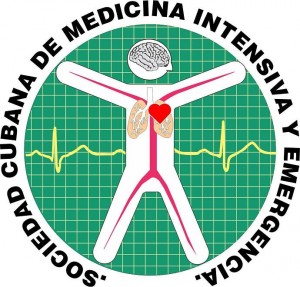Characterization of intravenous fluid therapy and hydro-mineral balance in intensive care
Keywords:
fluid therapy, water and electrolyte balance, critical care, rehydration solutions, electrolytesAbstract
Introduction: The management of intravenous fluids is common in intensive care units, but it has been little studied in the Cuban hospital context, as has the hydromineral balance.
Objective: To describe intravenous fluid therapy and hydro-mineral balance in patients admitted to serious care services of a hospital center.
Methods: A descriptive, prospective, cross-sectional study was carried out in the second semester of 2016. They participated in the study 196 patients who had been admitted to the Intensive Care Unit at Dr. Gustavo Aldereguía Lima Hospital General Universitario in Cienfuegos. A form was completed with data obtained from the interview, physical examination and medical history of each patient during their stay. Among the variables analyzed were cause of admission, type of intravenous fluid used for hydration, hydration status, hydro-mineral balance results, and blood electrolyte values. For statistical analysis, absolute frequencies and percentages were used.
Results: Elderly patients (62.2%) were the majority in the series, those admitted for respiratory diseases (23.9%) or postoperative major surgeries (22.9%), and with history of chronic non-communicable diseases (76, 9%). Crystalloid solutions were administered in all patients and 57.7% also had the enteral route. Colloids were used in less than 10% of those admitted. The water balance was predominantly neutral (39.8%) or positive (34.2%). 94.9% of the patients were clinically normally hydrated and 74.0% had normal diuresis. Plasma sodium and potassium measurements were normal in 64.3% and 55.6%, respectively.
Conclusions: Endovenous fluid therapy was performed in elderly, polymorbid individuals with various surgical or clinical diseases. The crystalloid solutions were administered to all patients. After 24 hours in the therapy units, the patients were normally hydrated, with mainly neutral or positive fluid balances, although with variations in the blood concentration of the main electrolytes.
Downloads
References
1. Myburgh JA. Fluid resuscitation in acute medicine: what is the current situation? J Intern Med 2015;277(1):58-68. Disponible en: https://doi.org/10.1111/joim.12326
2. Caballero López A, Domínguez Perera MA, Pardo Núñez AB, Abdo Cuza AA. Terapia Intensiva. Imagenología. Medio Interno. 4th ed. t.2. La Habana: Editorial de Ciencias Médicas; 2019 [citado: 15/06/2020]. Disponible en: http://www.bvscuba.sld.cu/libro/terapia-intensiva-ii-imagenologia-en-el-paciente-grave-medio-interno-cuarta-edicion/
3. Finfer S, Myburgh J, Bellomo R. Intravenous fluid therapy in critically ill adults. Nat Rev Nephrol. 2018 Nov;14(11):717. Doi: 10.1038/s41581-018-0060-0.
4. Martin GS, Bassett P. Crystalloids vs. colloids for fluid resuscitation in the Intensive Care Unit: A systematic review and meta-analysis. Journal of Critical Care. 2019;50:144-54. Doi: 10.1016/j.jcrc.2018.11.031
5. Van Haren F. Personalised fluid resuscitation in the ICU: still a fluid concept? Critical Care. 2017;21(Suppl 3):313. Doi: 10.1186/s13054-017-1909-5
6. Ramsay G, Baggaley A, Vaughan Shaw PG, Soltanmohammadi E, Ventham N, Guat Shi N, et al. Variability in the prescribing of intravenous fluids: A cross sectional multicentre analysis of clinical practice. Int J Surg. 2018 Mar;51:199-204. Doi: 10.1016/j.ijsu.2018.01.034.
7. De Dios Perera C, López Domínguez A, Rosales Rosales D, Rodríguez Sánchez VZ. Morbilidad y mortalidad en pacientes egresados de la unidad de cuidados intensivos de Contramaestre durante un bienio. Medisan. 2013 Mayo [citado: 20/06/2020];17(5):749-59. Disponible en: http://scielo.sld.cu/scielo.php?script=sci_arttext&pid=S1029-30192013000500002&lng=es
8. Medrano Montero J, Medrano Montero E, Medrano Montero J. Utilización de la Unidad de Cuidados Intensivos en el Hospital Vladimir Ilich Lenin. Correo Científico Médico de Holguín. 2016 Jun [citado: 20/06/2020];20(2):250-65. Disponible en: http://scielo.sld.cu/scielo.php?script=sci_arttext&pid=S1560-43812016000200004&lng=es
9. Delgado Fernández RI, Hernández Ruiz A, Castillo Cuello JJ, Hernández Varea JA, Vinent Llorente JA, Alcalde Mustelier GR. Caracterización de pacientes quirúrgicos de alto riesgo ingresados en terapia intensiva. Rev Cubana Cir. 2014 Dic [citado: 28/08/2018];53(4):388-96. Disponible en: http://scielo.sld.cu/pdf/cir/v53n4/cir07414.pdf
10. Zhou FH, Liu CH, Mao Z, Ma PL. Normal saline for intravenous fluid therapy in critically ill patients. Chinese Journal of Traumatology. 2018;21:11-5. Doi: 10.1016/j.cjtee.2017.04.012
11. Casey JD, Brown RM, Semler MW. Resuscitation Fluids. Curr Opin Crit Care. 2018 Dec;24(6):512-8. Doi: 10.1097/MCC.0000000000000551
12. Bacallao Méndez RA, Mañalich Comas R. Trastornos del equilibrio hidromineral y ácido-básico. Visión fisiopatológica. La Habana: Editorial Ciencias Médicas; 2017 [citado: 15/06/2020]. Disponible en: http://www.bvscuba.sld.cu/libro/trastornos-del-equilibrio-hidromineral-y-acido-base-vision-fisiopatologica/
13. Palmer BF, Clegg DJ. Physiology and pathophysiology of potassium homeostasis. Adv Physiol Educ. 2016;40:480-90. Doi: 10.1152/advan.00121.2016.
14. Marti G, Schwarz C, Leichtle AB, Fiedler GM, Arampatzis S, Exadaktylos AK, et al. Etiology and symptoms of severe hypokalemia in emergency department patients. Eur J Emerg Med. 2014;21(1):46-51. Doi: 10.1097/MEJ.0b013e3283643801.
15. Kardalas E, Paschou SA, Anagnostis P, Muscogiuri G, Siasos G, Vryonidou A. Hypokalemia: a clinical update. Endocrine Connections. 2018;7(4):R135-R146. Doi: 10.1530/EC-18-0109.
16.Vera Carrasco O. Hiponatremias en el paciente crítico. Rev Med La Paz. 2017 [citado: 24/09/2018];23(2):57-68. Disponible en: http://www.scielo.org.bo/scielo.php?script=sci_arttext&pid=S1726-89582017000200010






